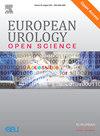Impact of Surgical Margin Status and Tumor Volume on Mortality After Robotic Radical Prostatectomy
IF 3.2
3区 医学
Q1 UROLOGY & NEPHROLOGY
引用次数: 0
Abstract
Background and objective
Positive surgical margins (PSMs) following radical prostatectomy (RP) have been seen as inherently unfavorable. However, a large international multi-institutional study recently revealed that unifocal PSMs (UPSMs) had no impact on prostate cancer–specific mortality (PCSM), whereas multifocal PSMs (MPSMs) did. Our aim was to assess the relative impact of PSMs versus percentage tumor volume (PTV) on PCSM.
Methods
We analyzed data for 1552 patients who underwent robot-assisted RP performed by a single surgeon between 2002 and 2018 at a tertiary referral center with up to 15-yr follow-up. Patients were divided into negative surgical margin (NSM), UPSM, and MPSM groups, with PTV stratification using a cutoff of 40%. The primary outcome was stepwise multivariate regression analysis of predictors of PCSM (pT stage, pathological Gleason grade group, PTV, UPSM, and MPSM). The secondary outcome was the risk of 15-yr PCSM via Kaplan-Meier analysis.
Key findings and limitations
The group with 40–100% PTV was older and presented with more advanced grade and stage. High PTV was significantly associated with greater risk of PSM, biochemical recurrence, PCSM, and overall mortality at 15 yr (p < 0.001). In addition to high stage and grade, MPSM predicted PCSM in multivariate analysis, but lost predictive significance when PTV was included. Limitations of the study include the retrospective nature and the single-center setting.
Conclusions and clinical implications
Our study further challenges the belief that MPSMs inherently have an adverse impact on PCSM. Instead, MPSMs appear to signify more aggressive underlying disease that predominantly drives oncological outcomes. We recommend considering PTV as a more reliable predictor of PCSM. While avoidance of PSMs remains a critical surgical principle, this goal in prostate cancer needs to be weighed against urinary and sexual function outcomes.
Patient summary
After surgery to remove the prostate in men with prostate cancer, samples from the edge of the prostate that are positive for tumor cells are called positive surgical margins (PSMs). Results from our study show that a PSM on its own is not necessarily an adverse factor. However, PSMs may be a sign of higher severity of prostate cancer. We found that men with a high tumor volume have a higher risk of dying from their prostate cancer.
求助全文
约1分钟内获得全文
求助全文
来源期刊

European Urology Open Science
UROLOGY & NEPHROLOGY-
CiteScore
3.40
自引率
4.00%
发文量
1183
审稿时长
49 days
 求助内容:
求助内容: 应助结果提醒方式:
应助结果提醒方式:


